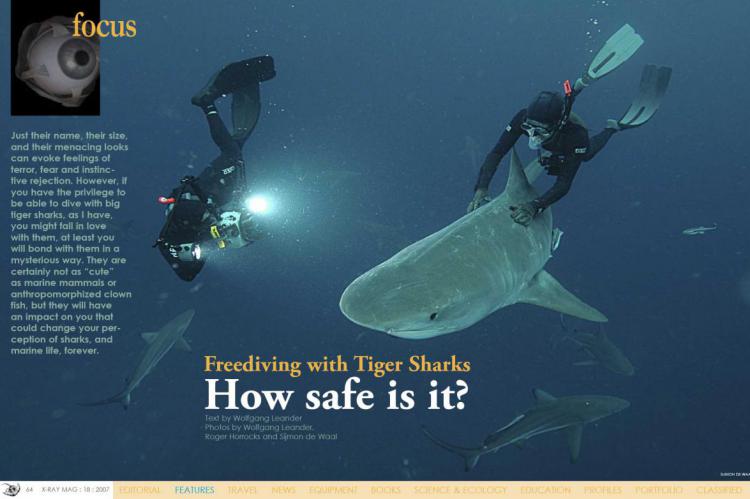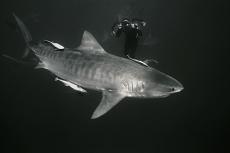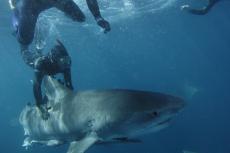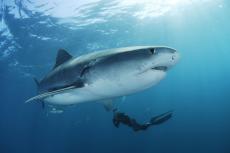Freediving with Tiger sharks
Just their name, their size, and their menacing looks can evoke feelings of terror, fear and instinctive rejection. However, if you have the privilege to be able to dive with big tiger sharks, as I have, you might fall in love with them, at least you will bond with them in a mysterious way. They are certainly not as “cute” as marine mammals or anthropomorphized clown fish, but they will have an impact on you that could change your perception of sharks, and marine life, forever.
“Dangerous” can be circumstances and wrong attitudes like harassing or provoking them, or else disregarding other basic safety rules such as not spear-fishing in their presence. Being with tiger sharks in a feeding situation where they might view you as an intruder or a competitor could incite them to display dominance, which, if not recognized and respected, could possibly trigger a bite.
Chumming
Typically, shark operators will bait tiger sharks with chum or fish parts in a perforated plastic drum, which has proven to be a safe method to attract them. Some people are opposed to baiting sharks—they allege that baiting sharks alters their attitude toward divers, as they will associate humans with food. Unfortunately, ignorance fuels fears. There is absolutely no evidence that baiting conditions sharks to attack people. As a rule, however, you can say this—no bait, no sharks.
Sharks are shy and elusive, especially the larger ones. Therefore, if you are against baiting sharks, chances that you will see them and get close to interact with them are rather slim. As any shark photographer will tell you, there is no way to approach tiger sharks unless one attracts them with chum and fish carcasses.
Behavior
To be sure, tiger sharks are not “docile” marine animals, even though they swim slowly compared to other more nervy sharks and, thus, appear to be “cool”. They are formidable and highly developed predators capable of hunting other sharks and biting through the shells of sea turtles. Not understanding and correctly interpreting their body language is probably the highest potential risk factor while encountering them in their environment. Apart from that one should always be aware of the fact that sharks, especially the “requiem” sharks, have no serious adversaries in the oceans, which makes them the undisputed lords of their habitat.
Attacks
So, what about so-called shark attacks? I would venture to say that not more than five to ten tiger shark related accidents happen each year worldwide, of which perhaps one or two may result in fatalities. According to the Princeton-based Shark Research Institute (SRI), between 2000 and 2006 some 35 incidents involved tiger sharks; only eight of these were recorded as fatal. The SRI lists the shark species in their global shark attack files only when they are 99-100 percent certain about it. Surfers, swimmers, and spear-fishermen appear to be at a higher risk of being bitten by a tiger shark than snorkelers and scuba divers.
These findings, although not complete as not every incident is being reported, simply confirm that tiger sharks—or any sharks for that matter—are not at all what ignorant and sensationalistic media people still call the “monsters of the deep” or “mindless killing machines”.
That said, diving with sharks, even with fully grown tiger sharks, should not be regarded as a “hazardous” activity or an “extreme” sport. If you want to dive with tiger sharks, and assuming that you have some experience diving with other sharks, the question should not be: Is it safe or not? Rather, the question is whether to freedive or scuba dive with the sharks.
To freedive or not to freedive...
I prefer freediving for two very basic reasons. First, as a mammal, I find it unnatural to breathe underwater, and second, interacting with sharks requires a high degree of corporal mobility, which in my opinion only apnea diving will allow you. But then again, this is my choice. Most other people will feel more comfortable diving with tanks—being relaxed underwater is really what recreational diving should be all about.
I began freediving 52 years ago in southern France, and to this day I can still fully relive the overwhelming sensation I felt then being able to enter into another world—Cousteau’s silent world—and weightlessly swim in it.
Freediving with tiger sharks for the first time in my life and just four months ago in the Bahamas in a place called Tiger Beach, left me just as breathless, literally, as I was back in 1955. To swim with tigers spoiled me completely. I have to admit that all other sharks I have seen and swum with—even large specimens—pale in comparison.
No other sharks have a stronger expression of character than tiger sharks—the square head, the wide, blunt front, the comparatively huge mouth—often tightly shut when they get very close—and those inquisitive, intelligently looking black eyes.
When I saw the first tiger shark swimming out of the blue mist of the Bahamian sea—which struck me as the quintessential shark—I felt reborn, miraculously invigorated by the spell of a perfect animal that has already been around long before the dinosaurs roamed our planet.
A few weeks after my first encounter with tiger sharks in the Bahamas, I flew to South Africa to freedive with the tiger sharks of Aliwal Shoal. Here, I was able to experience the most incredible interaction with big tiger “girls”. Swimming up very close to these gentle creatures was what I would call the climax of a lifelong love affair with the ocean and its sharks.
Close encounters
As a freediver, I have had my close encounters of the “striped” kind mostly at the surface where the tigers look their best, photogenically speaking. Nothing beats the sight of a tiger shark that comes up to the surface to check you out. Once the tigers feel good about you and move in perhaps a bit too close for your taste, don’t panic—just place your hand on their heads and push them down very gently.
Never, never hit a shark on its nose as some “experts” advise. Handling sharks roughly is asking for trouble. Sharks are sensitive and responsive. They can tell a klutz from a tactful person.
Location
Which place is “better”—Tiger Beach or Aliwal Shoal? This is a tough question, which I have been asked many times after I returned from South Africa. Both spots are great. To my knowledge, these locations are the only ones in the world where you are (almost) guaranteed to see tiger sharks on every dive.
Tiger Beach in the Bahamas is what you’d expect from first class tropical diving in pristine waters—the visibility is superb, and the sandy bottom as background makes for “clean” photographs and videos. The diving is easy, and as you can get there only on a live-aboard (Jim Abernethy of Scuba Adventures and Scottie Smith of the Dolphin Dream Team are the guys to go with), you have unlimited dives while anchored at Tiger Beach.
Aliwal Shoal, in contrast, is for the hard core shark divers—darker waters, usually less clear than in the Bahamas, at times rough launches from the beach as the skippers have to get past the surf.
However, if what you are looking for is close and intense interaction with tiger sharks, I’d recommend that you go all the way to Umkomaas, about 25 miles south of Durban, and book at least 7-10 dives with the operator I consider the most experienced, and whose team members are all excellent, enthusiastic shark divers, with or without tanks—Blue Wilderness.
Mark Addison of the Blue Wilderness team pioneered tiger shark diving in South Africa and is the guy people like David Doubilet and Doug Perrine go with if they want to photograph the tigers or dive the by now famous Sardine Run. Perrine shot his award winning image of the copper shark coming out of a cloud of sardines there.
What’s next...
My next diving plans? In December 2007, I will be back at Tiger Beach, with the Dolphin Dream Team, and in March 2008, you’ll find me with my son Felix in South Africa where we have some great friends waiting for us—Roger Horrocks (www.rogerhorrocks.com), the Blue Wilderness team, and, of course, “my” girls, of which one I will take out for a dance to renew our special relationship...
I am hopelessly hooked on tiger sharks. I love them. They are to me the paradigmatic sharks—the sharks of sharks. If somebody would ask me what I feel for them, for all sharks, this is what I would state:
We have stripped them of their dignity, we have vilified them throughout the ages, we feared them irrationally out of ignorance, and now we persecute them mercilessly, exploit them as if they were a commodity. We have likened their innocence to the worst of human traits, not wanting to admit that the darker side of our nature is not bestial but human. We have refused to realize in our hubris that our God is the God that also created them, not a lesser god, a god of sharks—peace to them, finally. ■
Editor’s note: The opinions expressed by Wolfgang Leander in this article reflect his own assessment of diving with sharks. While we believe that diving with them is relatively secure if and when generally accepted safety rules are observed, it should be stressed that sharks are wild animals and accidents could happen.
Download the full article ⬇︎

Originally published
X-Ray Mag #18
Soccoro Island a.k.a. islas Revillagigedos. Wolfgang dances with Tiger - free diving with Tiger sharks. Manta Ray Ecology. Great White Shark diving - with no cages Science of Sound in water. Diving solo with rebreathers - safely. Mastering Strobe Photography







